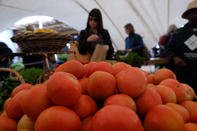Ancient Famine

Back in the day, the Irish learned the hard way that monocropping is one of farming's more risky practices. Struggling under a punitive rent and taxation system imposed by their British colonisers, subsistence farmers turned to potatoes, which produced relatively large yields from small and soil-deficient plots. In 1845 the potato blight found its way from America into the Irish potato crop. When the crop failed across the island, a million lives were lost - probably one eighth of the population. Many more emigrated to Britain, the United States and Canada.
In India, failure of the monsoon claimed 5.5 million lives, from 1877 to 1879. At the same time, drought across northern and central China starved nine to thirteen million people to death - the worst natural disaster in history. The tragedy about famines and their gargantuan mortality rates is that they are not always caused by a shortage of food but by “lack of available land, poverty, rising food prices...leaving people either unable to grow their own food to survive or earn enough money to buy it”.
Lack of political will has claimed its share of decimated corpses. During the Ethiopian famine of 1984, when nearly one million people starved to death, the Western girth was straining at its waistband. Europe had a bumper harvest that year and ample food made its way to the struggling African Sahel region. Ethiopia's government chose to reroute that food from its starving poor to the troops fighting a border war with Eritrea.
The same collectivisation policies implemented by Mao Tse-Tung's regime in communist China brought about the worst famine in human history. Joseph Becker 's text Hungry Ghosts, Mao's Silent Famine, states that the rest of the world struggled to believe the figures which finally emerged - 30 to 40 million people are believed to have died from 1958 to 1961. That's nearly the population of South Africa, wiped out in a matter of three years.
Eating Better

Ancient famines were localised and took place at a time before air travel and modern communication made it possible to ship food from lands of plenty, to places where babies no longer had the energy to suck from their mothers' breasts. Surely, our great advances in modern transportation and global communication, must come to the rescue of every skeletal child at the short end of decades of food shortages and war? Surely the Green Revolution will save the world's hungry?
Thanks to advances since the 1960s in high-yield crops, irrigation, fertilisers, pesticides as well as other improvements in farm management, food production is keeping pace with population growth. Now that the global population has broken through the seven billion mark, we've got nearly half of the land's surface under agriculture and there is more than enough food to go around.
There's more food to go around these days and even poorer countries are eating better. The United Nations Food and Agriculture Organization (FAO) reports that the percentage of undernourished people has been dropping since the late 1960s, and the average daily calorie intake of developing countries is expected to exceed 3 000 kilocalories (kcal) by 2030. Diets will become more varied for more people and nutrition will improve.